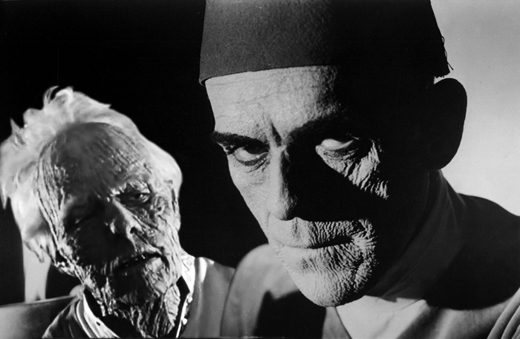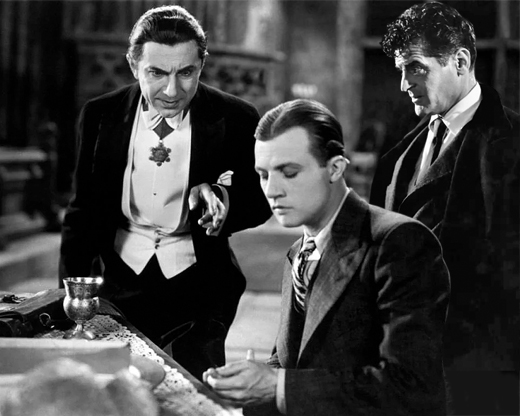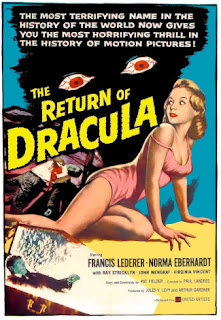As far as genre movies go, we normally think of the 1950s as a high water mark for sci-fi. The Cold War, the Bomb and the Red Scares in the U.S. led to a veritable invasion of giant radioactive creatures and malevolent aliens (as stand-ins for the Russians) on theater and drive-in screens. And when movie astronauts managed to reach the Moon, Mars and other assorted planets, they found plenty of threats to the American way of life in those places as well.
By the time the fifties rolled around, the classic Universal monsters were on life support, acting as comedic foils for Abbott and Costello. They were not a great fit for the new Atomic-powered Space Age (at least until Hammer revived the Gothic monsters in glorious Technicolor toward the latter part of the decade). And yet, while Universal was going all-in on sci-fi (It Came from Outer Space, Creature from the Black Lagoon, This Island Earth, The Mole People, etc.), some independent B moviemakers were reluctant to let go of the classic monsters, reviving them with their own unique spins.
“Updated for modern audiences” was as much a thing back then as it is today. In some cases, traditionally supernatural monsters such as vampires and werewolves were brought up-to-date with sci-fi origins -- Blood of Dracula (1957), The Vampire (1957), The Werewolf (1956), and I Was a Teenage Werewolf (1957) being notable examples (see my mini-reviews of the first two here and here).
In other cases, Gothic characters like Dracula and Frankenstein’s descendants abandoned their gloomy, cobwebbed castles and took up residence in Suburbia, USA (The Return of Dracula, 1958; I Was a Teenage Frankenstein, 1957; Frankenstein’s Daughter, 1958).
If you’re like me, Halloween season viewing always includes at least a couple of films from Universal’s Golden and Silver monster eras. But the ‘50s B-list knock-offs would like you to consider inviting them to the party as well. Without further ado, here they are photobombing their more famous cousins to grab a little of the limelight for themselves.
I suppose if you've become a werewolf, it doesn't matter if the cause was science or the supernatural -- the extra-long incisors, the itchy fur and the sudden taste for human flesh are inconvenient and annoying regardless.
In poor Duncan Marsh’s case, he was minding his own business, traveling through a remote mountain town when he crashed his car and was treated by two local “doctors” who just happened to be utterly mad. They injected Marsh with an experimental serum that reverts humans to a more primitive form (although why it should be a wolf and not some sort of hominid is anyone’s guess).
Marsh isn’t even accorded the dignity, like Larry Talbot, of being bitten by a werewolf while trying to save someone’s life. He was just in the wrong place at the wrong time, a victim of 1950s-style mad science.
 |
| Duncan was impressed with Larry’s self-confidence and ability to pick up women. |
Unlike the original monster, Teenage Frankenstein seemed to have everything going for him. Instead of being stitched together from the parts of paupers and condemned murderers, the teen monster was created from the formerly healthy bodies of teen crash victims: the head and torso of Bob, a teen hod-rodder, and the arm of a wrestler and the leg of a football player.
Okay, so his face was not pleasant to look at, but even that was eventually solved with a transplant. And instead of being chained in a dank castle dungeon, Bob had the run of a comfortable American suburban home.
To top it off, Bob had an indulgent, if somewhat controlling surrogate father in the form of Prof. Frankenstein, a descendant of the original mad scientist, working as a guest lecturer at an American university.
But of course, like all teens, Bob was rebellious, and eventually somebody was going to get fed to the pet alligator that the Professor kept in a pit below the basement.
 |
The guys told Bob he was too young to party with them, but he
suspected it was really because of his looks. |
The mummy is the ultimate working stiff -- he not only works until he drops, he works long after he drops. Pity poor Imhotep, Universal’s original mummy, who lay dormant for 3,000 long years before being revived by the Scroll of Thoth to wreak vengeance on his tomb’s defilers and reunite with the reincarnation of his beloved princess.
The revived High Priest of Pharaoh’s Curse had it better in a couple of ways. Whereas Imhotep was forced to use his own creaky 3,000-year-old body to deal with the defilers, the Priest’s spirit merely had to be transferred from his mummified remains to one of the archaeological team’s assistants (Numar) for the curse to be fulfilled.
Not only that, but he had the assistance of Simira, the alluring embodiment of an ancient Egyptian cat goddess, to take revenge on the non-believers. Faced with that formidable tag-team, the archaeologists never had a chance.
 |
| Numar wondered what sort of face cream Imhotep used for his fine lines and wrinkles. |
If the monster in Bride of Frankenstein had been presented with Frankenstein’s Daughter instead of Elsa Lanchester, there’s no doubt he would have skipped the attempt at hand-holding and gone straight to the lever to blow up the laboratory.
Frankenstein’s Daughter has a face not even a mother could love, which is okay because instead of a mommy she has two daddies, Carter Morton, a scientist who wants to rid the world of disease, and Oliver Frank, a descendant of the original Frankenstein who wants to carry on with the family work.
They’ve been conducting their crazed experiments in a suburb of Los Angeles, which is okay, because in freaky Southern California, who’s going to notice a couple of eccentric doctors making monsters out of relatives and neighbors?
Frankenstein’s Daughter is ground-breaking because it answers the age-old question, “Can you just slap lipstick on an abomination stitched together from parts of dead Californians and call it a success?” Why yes, yes you can.
 |
It finally dawned on Frankenstein’s Daughter that she was always
going to be a bridesmaid and never a bride. |
Quick quiz: If you were an aristocratic vampire who had recently sold his ancestral castle in the Carpathian mountains in order to relocate to his dream (or should I say nightmare?) destination, where would you go?
A.) A deserted but stately abbey in the heart of London where you could dress up in a tux and tails and go out to feed on the cream of London society?
Or,
B.) A nondescript house in a small California town owned by yokels who think you’re their weird cousin from Central Europe, and where you would stick out like an undertaker at a Chuck E Cheese birthday party?
If you answered B, then you will certainly identify with the vampire in The Return of Dracula, who for some reason prefers the blood of pimply-faced Americans to London sophisticates, which is kind of like preferring Costco box wine to a bottle of 1949 Domaine Leroy Richebourg Grand Cru.
But hey, you gotta be you, just like Belloc Gordo (aka Count Dracula, aka Francis Lederer) in this eccentric vampire film from the ‘50s.
 |
| Belloc quickly realized that he was going to get stuck with leftovers again. |












